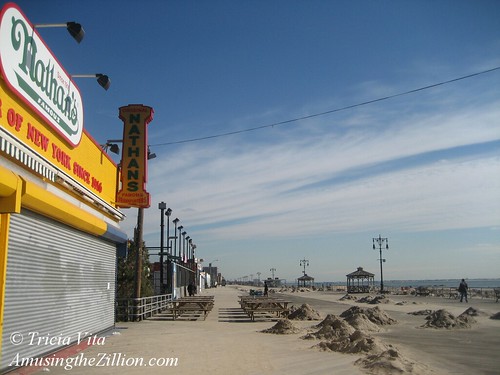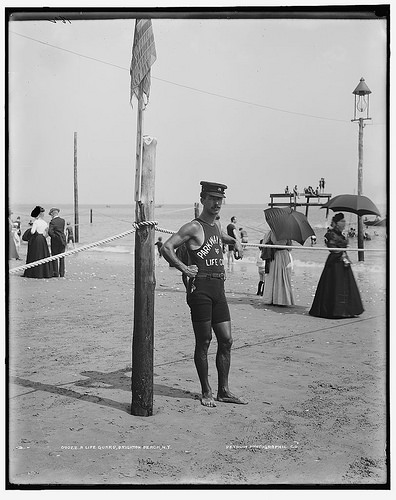
Dignitaries on ‘Boardwalk’ made from Coney Island Boardwalk wood during May 1st opening ceremony of USA Pavilion, Milan Expo 2015. Photo via USA Pavilion at Expo Milano 2015 Facebook
One day in the not too distant future, the wooden Coney Island Boardwalk may exist only in recycled form, far away from the People’s Playground, in venues frequented mostly by the privileged classes. The May 1st opening of the Milan Expo provides a window into that future. The Expo’s $60 million USA Pavilion boasts a 300-foot walkway said to be made of repurposed ipe wood from the Coney Island Boardwalk.
“The middle floor is a boardwalk, boardwalks have historically been avenues of food and community, and fun too!,” writes Dorothy Cann Hamilton, the President of the Friends of USA Pavilion at Expo Milano 2015. “We were able to purchase the actual Coney Island boardwalk after Hurricane Sandy.”

Architects rendering of Milan Expo’s USA Pavilion featuring a walkway of Coney Island Boardwalk wood. The $60 million pavilion project was privately funded by the James Beard Foundation, International Culinary Center and the American Chamber of Commerce in Italy. Biber Architects, New York
The project’s architect James Biber of Biber Architects, a New York City-based architecture firm, said in an interview on the Pavilion’s website that “Americans’ fascination with the road inspired our boardwalk concept, which is really the backbone of the whole experience. Visitors will take a trip through the USA Pavilion – up the boardwalk and back down – and constantly be on the move.”
Meanwhile, in Brooklyn, wooden sections of the Brighton Beach end of the Boardwalk are being torn up to be replaced with a walkway made of recycled plastic lumber and a 10-foot wide concrete “carriage lane” for so-called “emergency vehicles.” The $10 million pilot project is seen as the City’s plan for the future of the entire boardwalk, except for a few blocks in the amusement district that will continue to be made of ipe wood.
And Coney Island’s heroic City Councilman Mark Treyger is trying to persuade the City’s Landmarks Commission that the Boardwalk should be declared a Scenic Landmark despite a previous rebuff.

Boardwalk Reconstruction in Brighton Beach, where a new plastic and concrete ‘boardwalk’ is set for completion in May 2016. Photo by Lonnie Luchnick via Friends of the Boardwalk Facebook
The Parks Department’s page about the Coney Island Boardwalk Reconstruction at Brighton Beach says “Replacing this portion of the boardwalk (Coney Island Avenue to Brighton 15th Street) using hardwoods could destroy some 6,000 acres of tropical rainforest, while 45,200 acres would be destroyed to reconstruct the entire boardwalk.” But instead of opting for a treated wood such as Kebony, which has been used at Delaware’s Bethany Beach Boardwalk (Parks claims Kebony is “only available in Europe”), or a wood over concrete substructure like Ocean City, Maryland, the City went for the cheapest and least aesthetically pleasing –a concrete and plastic surface.

Parks Dept rendering of boardwalk reconstruction underway in Brighton Beach. a 10-foot-wide concrete carriage lane will be included in the 50-foot-wide boardwalk.
The Milan Expo project caught our eye a few months ago via a dramatically titled news story “Sandy-ravaged Coney Island boardwalk turned into showpiece.” Coney Island Boardwalk, the brand, commands attention, and rescuing discarded boards to make into something new and beautiful is commendable. But in fact, the Coney Island Boardwalk was NOT ravaged by Sandy but survived intact, though the same can’t be said for the neighborhood or Steeplechase Pier.
Berms built on the beach protected the boardwalk, which was inundated with sand that was shoveled into tidy piles and returned to the beach. We’re not sure who started the ravaged boardwalk myth but it enables Parks’ claim that plastic lumber was more resilient than wood during Sandy, a fact disputed by actual residents of the neighborhood. The producers of luxury products made from Coney boardwalk wood, including such trinkets as a $195 knife with an ipe handle, unwittingly perpetrate the myth in their blurbs.

Coney Island Boardwalk a few days after Sandy. November 5, 2012. Photo © Tricia Vita
In fact, the Parks Dept. has been giving away and/or selling the wood for several years in the course of redoing sections of the boardwalk. The wood was torn up before the storm so that a new concrete surface could go down at Sea Gate and Brighton. Some boards are removed during regular maintenance and replaced with new ipe. There will be plenty more wood to go around now that they’re tearing up the boards in Brighton in a pilot project that was infamously approved by the Public Design Commission despite popular opposition.
What the City of New York doesn’t want you to know, but anyone who lives or works along the boardwalk can tell you, is that the 2.51 mile pedestrian walkway is now routinely used as a roadway by Parks Department and NYPD vehicles, not just for emergencies. It is this everyday use which causes enormous wear and tear to the boards, which frequently pop up while whole sections cave in and have to be replaced.

The City of New York’s routine use of trucks and cars on the Coney Island Boardwalk causes wear and tear on the boards. The Parks Dept is starting to build a 10-foot wide concrete ‘carriage lane’ in Brighton Beach. Photo © Anonymouse
In June of 2012, months before Sandy, when the Barnes Foundation’s new museum opened with flooring made of Coney Island Boardwalk wood, an article in the NY Times explained how it got there: “The parks department says it tries to reuse what it can but then allows contractors to sell, discard or give away the rest. (The city makes no money from it.) That is how an architectural salvage company in Philadelphia came to haul away 20 trailer loads of Coney Island wood in 2010.”
While repurposing discarded lumber is eco-friendly and gives a building a LEEDS rating, there’s something incongruous about sending this heavy wood more than 4,000 miles to Italy for an expo trumpeting sustainability. “Indoor and outdoor decking made of salvaged Coney Island boardwalk lumber will eventually be re cycled again,” according to the US Pavilion’s Sustainability Fact Sheet. Well, good, so Europeans can enjoy decks made from Coney boardwalk wood too. Or it will be shipped 4,000 miles back home.

Sign at rally to save boardwalk from becoming concrete: This is SUPPOSED to be the DE BLASIO ADMINISTRATION not BLOOMBERG. January 18, 2015. Photo © Tricia Vita
The People’s Playground and the people of New York have been getting buncoed. As one of the commenters said in the NY Times story from 2012: “So the wood, which was payed [sic] for with tax payer dollars, is given away for free and then sold and used in hi end furniture, restaurants and museums? These people and places with no real association to Coney Island now claim some connection to the fabled boardwalk. Because they bought the wood that I helped pay for that the city gave away.”

Ambassadors stand on ‘Boardwalk’ made from Coney Island Boardwalk wood during May 1st opening ceremony of USA Pavilion, Milan Expo 2015. Photo via USA Pavilion at Expo Milano 2015 Facebook
Related posts on ATZ…
January 19, 2015: An Historic First As Elected Officials Join Community’s Fight to Save Coney Island Boardwalk
March 22, 2012: The Coney Island-Brighton Beach Concretewalk Blues
March 9, 2012: The 10 People Who Will Decide the Fate of Coney Island Boardwalk
December 27, 2010: Photo of the Day: First Snow on Coney Island Boardwalk
Read Full Post »



















